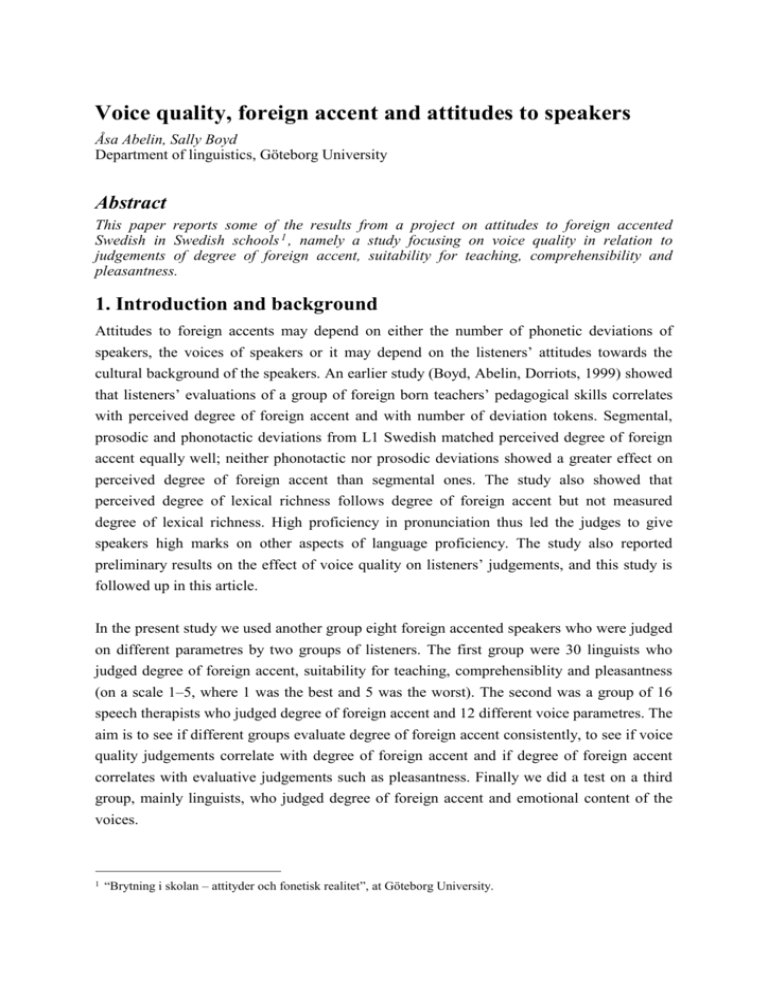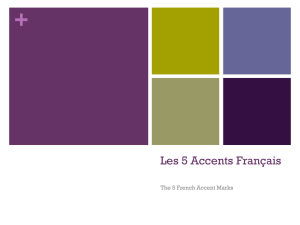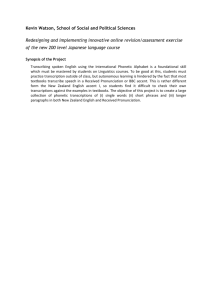Voice quality, foreign accent and attitudes to speakers
advertisement

Voice quality, foreign accent and attitudes to speakers Åsa Abelin, Sally Boyd Department of linguistics, Göteborg University Abstract This paper reports some of the results from a project on attitudes to foreign accented Swedish in Swedish schools 1 , namely a study focusing on voice quality in relation to judgements of degree of foreign accent, suitability for teaching, comprehensibility and pleasantness. 1. Introduction and background Attitudes to foreign accents may depend on either the number of phonetic deviations of speakers, the voices of speakers or it may depend on the listeners’ attitudes towards the cultural background of the speakers. An earlier study (Boyd, Abelin, Dorriots, 1999) showed that listeners’ evaluations of a group of foreign born teachers’ pedagogical skills correlates with perceived degree of foreign accent and with number of deviation tokens. Segmental, prosodic and phonotactic deviations from L1 Swedish matched perceived degree of foreign accent equally well; neither phonotactic nor prosodic deviations showed a greater effect on perceived degree of foreign accent than segmental ones. The study also showed that perceived degree of lexical richness follows degree of foreign accent but not measured degree of lexical richness. High proficiency in pronunciation thus led the judges to give speakers high marks on other aspects of language proficiency. The study also reported preliminary results on the effect of voice quality on listeners’ judgements, and this study is followed up in this article. In the present study we used another group eight foreign accented speakers who were judged on different parametres by two groups of listeners. The first group were 30 linguists who judged degree of foreign accent, suitability for teaching, comprehensiblity and pleasantness (on a scale 1–5, where 1 was the best and 5 was the worst). The second was a group of 16 speech therapists who judged degree of foreign accent and 12 different voice parametres. The aim is to see if different groups evaluate degree of foreign accent consistently, to see if voice quality judgements correlate with degree of foreign accent and if degree of foreign accent correlates with evaluative judgements such as pleasantness. Finally we did a test on a third group, mainly linguists, who judged degree of foreign accent and emotional content of the voices. 1 “Brytning i skolan – attityder och fonetisk realitet”, at Göteborg University. Voice characteristics involve a number of factors, not only characteristics of larynx setting but also of prosody and articulation (Lindblad, 1992). Research by e.g. Abelin & Allwood (1999), Johnstone & Scherer (1999), Paeschke, Kienast, Sendlmeier (1999), Piot (1999), Zetterholm (1999) indicate that F0 is an important carrier of emotional information and could thus also give rise to emotional reactions and attitudes. For this reason we also focused on judgements of global characteristics such as pitch level and pitch-varation. The research questions in this second study were: 1) Do judges estimate degree of foreign accent consistently? 2) Are speakers’ voice qualities related to perceived degree of foreign accent? 3) Is degree of foreign accent related to estimated teacher suitability? 4) Is degree of foreign accent related to comprehensibility? 5) Is comprehensibility related to pleasantness? 6) How are voice quality parametres related to interpreted emotional state? 2. Method Nine women with different foreign accents were recorded in two different situations: teaching a class and reading aloud. The nine subjects had different L1:s: Polish (2 speakers), Spanish, Finnish, Somali, Dutch (2 speakers, one of them only reading), German (only teaching) and Farsi. 30 second samples of these recordings were mixed onto a test tape. The recordings were presented to 30 judges, who were linguists or teachers of Swedish as a foreign language. These listeners were instructed to give judgements on a scale 1–5 for the following parametres: “degree of foreign accent”, “teacher suitability”, “comprehensibility” and “pleasantness”. The same testtape was also judged by 16 students of speech pathology. They were told to judge the voices in regard to 12 voice dimensions: pitch level, pitch variation and strength of voice and also other voice characteristics normally used for describing pathological voices: vocal fry/creaky, unstable voice quality, hyperfunctional, hypofunctional, breathy, aphonic, hard glottal attacks, rough and voice breaks. The speech pathologists also judged degree of foreign accent of the speakers. Degree of accentedness is thus estimated by both listener groups. Boyd, Abelin, Dorriots (1999) showed, for another group of speakers, that there is good agreement between listeners’ estimation of degree of foreign accent and number of pronunciation errors, i.e. error tokens. Therefore, in this experiment, we did not do an analysis of number of errors, but we were content with letting subjects estimate degree of foreign accent. We did a test on yet another group, mainly linguists, who judged degree of foreign accent and emotional content of the voices. These results are not analyzed in detail yet. 3. Results The judgements and estimations of degree of foreign accent gave the following results. 1. Both listeners groups ranked the speakers’ degree of foreign accent, when teaching, in exactly the same way, except for one speaker "Nos". Table 1. The speakers ranked after degree of foreign accent, as judged by the linguist group and the speech pathologists group (1 = least accented; 5 = most accented). linguist group speech pathologists Jas/Somali Sil/German Nos/Farsi Hen/Dutch Gil/Spanish 1,5 2,2 2,8 2,8 3,0 1,7 2,3 Mar/Finnish Bog/Polish Kry/Polish 3,0 3,9 4,1 2,6 3,0 3,3 2,0 2,4 2,5 2. Degree of foreign accent correlates significantly with the global parametres pitch level (r = .323; p<.0001) and strength (r = .259; p<.0001). It also correlates significantly with the non global parametres vocal fry/creaky (r = .232; p<.0006), unstable voice quality (r = .402; p<.0001) hyperfunctional (r = .393; p<.0001) and hard glottal attacks (r = .340; p<.0001). It does not correlate with F0-variation, hypofunction, aphonic, rough voice quality or voice breaks. High values are correlated with higher degree of foreign accent. e.g. high pitch and strong voice correlate with high degree of foreign accent. 3. The speakers are ranked in exactly the same order on the parametres degree of foreign accent and teacher suitability. Table 2. The speakers ranked after judged degree of teacher suitability, which correlates with ranking of degree of foreign accent, as judged by the linguist group. The table also shows marks on the parametres comprehesibility and pleasantness. foreign accent teacher suitability compre-hen pleasant-ne sibility2 ss3 Jas/Somali Sil/German Nos/Farsi 1,5 2,2 2,8 1,5 1,7 2,0 1,5 1,7 3,2 2,2 1,8 2,9 Hen/Dutch Mar/Finnish Gil/Spanish Bog/Polish Kry/Polish 2,8 3,0 3,0 3,9 4,1 1,9 2,1 2,3 2,6 2,6 2,0 2,0 2,2 3,4 3,4 2,6 2,8 3,1 4,2 3,7 4. All these parametres correlate with all. However, degree of foreign accent correlates less well with the more esthetic parameters and best with comprehensibility (r = .770; p<.0001). 5. Every speaker (except Nos) has a higher evaluation on comprehensibility than on pleasantness.This could indicate that comprehensibility is a prerequisite for good marks on pleasantness; judges can not make esthetic judgements without understanding what they hear. The speakers can, on all the parametres, be grouped into three groups. Two of the speakers were considered best, two of them worst and the rest in between. 6. The third group that tried to interpret the emotional state of the nine speakers found the task difficult. These data are not analysed in detail yet, but strong voice seems to be asscoiated with dominance or anger while weak voice is associated with fear or shyness. These results are in accordance with e.g. Abelin & Allwood (1999). 4. Summary and discussion Research questions 1 was answered “yes”: Judges do estimate degree of foreign accent consistently. This is even more interesting considering that the 8 speakers had 7 different first languages. 2 3 For both reading and teaching. For both reading and teaching. Question 2 was answered “yes”: Degree of foreign accent correlates with a number of voice qualities. Of the global ones it correlates with pitch level and strength of voice but not with pitch variation. Question 3 was answered “yes”. Speakers were ranked in almost the same way on the parametres degree of foreign accent and teacher suitability. Question 4 was answered “yes”. Degree of foreign accent correlates highly with comprehensibility. Question 5 was answered “yes”. Comprehensibility correlates with judgements on pleasantness. It was suggested that comprehensibility could be a prerequisite for positive judgements on pleasantness. Since many of the parametres correlate it seems that judges make global judgements where more evaluative judgements are based on degree of foreign accent. As shown i Boyd, Abelin, Dorriots (1999) estimated degree of foreign accent correlates with number of deviation tokens. That earlier study on five speakers showed that estimated degree of foreign accent is wrongly generalized to both judgements on lexical richness and grammatical correctness. Research question 6 does not yet have an answer, but partial analyses show that strong voice seems to be associated with dominance or anger, while weak voice is associated with fear or shyness (which is expected according to Abelin & Allwood, 1999). This is also interesting comparing the voice judgements of the speech pathologists and the estimations of degree of foreign accent; greater degree is associated with strong voice (typically related to anger, dominance and disgust) and high pitch. Thus, there might be more to judgements on foreign accent than perceived number of phonetic deviations. References Abelin, Å., Allwood, J. (1999) Tolkning av svensk känsloprosodi - en kontrastiv studie, Inst. för lingvistik, Göteborgs universitet (ms) Boyd, S., Abelin, Å., Dorriots, B. (1999) ’Attitudes to foreign accent’ in Proceedings from Fonetik 99, GPTL 81. Göteborg. Johnstone, T., Scherer, K. R. (1999) ’The effects of emotions on voice quality’, in Proceedings from International Conference of Phonetic Sciences 99, Univ. of California. Berkely Lindblad, P. (1992) Rösten, Studentlitteratur. Lund Paeschke, A., Kienast, M., Sendlmeier, W.F. (1999) ’F0-contours in emotional speech’, in Proceedings from International Conference of Phonetic Sciences 99, Univ. of California. Berkely Piot, O. (1999) ’Experimental study of the expression of emotions and attitudes in four languages’, in Proceedings from International Conference of Phonetic Sciences 99, Univ. of California. Berkely Zetterholm, E. (1999) ’Emotional speech focusing on voice quality’ in Proceedings from Fonetik 99, GPTL 81. Göteborg.






